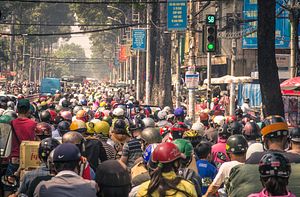Vietnamese traffic: locals know it; everyone complains about it. Tourists photograph it and share their experiences back home. But for pedestrians, crossing the streets can be a daunting affair.
Vietnam has made great strides economically. But amid the soaring economy and rise in tourism, roads and traffic policing have not kept pace with the increasing number of vehicles on the road. The high traffic congestion in Vietnam is a hazardous enterprise that results from an excessive number of motorbikes and limited infrastructure capacity. The road system has fallen behind population growth and the rising number of vehicles on the streets, resulting in gridlock and traffic jams even during non-peak hours.
In most areas, the traffic can grind to a complete standstill. Bike riders and motorcyclists ride on sidewalks meant for pedestrians and leisurely cruise down one-way streets going the wrong way. It is not an uncommon sight to see two to four people on a single motorbike.
The heavy motorbike density can be attributed to how expensive car ownership can be. Car owners have to pay VND 300 million ($13,ooo) for an automobile due to high production costs and a special consumption tax. Hence almost 95 percent of registered vehicles are motorbikes or scooters, and as many as 9,000 new motorcycles join the roads each day.
This high traffic density results in a high death toll each year, known as Vietnam’s “hidden epidemic.” While the Ministry of Public Security reported over 11,000 deaths in 2010, the Ministry of Health registry — collected through the hospital system — reported 15,464 deaths. However these numbers may underestimate the actual number of deaths and injuries, and grossly understate the severity of the problem.
There have been some efforts to improve safety standards, such as the introduction of motorcycle helmets as a road safety intervention to reduce the frequency and severity of head injuries from traffic crashes. It has been estimated that 60 percent of all road traffic injuries happen between motorcycle drivers and passengers.
In 2001, a law was introduced where wearing a helmet became mandatory for all motorcycle drivers on specific roadways such as national highways. By 2007, the government released another decree that made it mandatory for all motorcycle drivers to wear a helmet on all roads. However, there was little government enforcement and motorcycle drivers carried on without using a helmet.
Another issue is the quality of helmets used by motorcycle drivers. According to Jonathan Passmore of the World Health Organization (WHO), 80 percent of helmets fail to meet national quality standards. Most of the helmets that are available in Vietnam are made of cheap and low quality plastic, which doesn’t offer sufficient protection.
Beyond the helmet law, the government has tried to address road congestion by constructing elevated highways, ring roads, outer belts, and bridges to handle more traffic and restricting access by limiting or redirecting traffic (including taxi restrictions), charging parking fees, reducing parking spaces, and creating toll roads.
According to experts, these measures have often been somewhat effective in the short-term. However as the urban population grows exponentially and more people flock to the cities, it is only a matter of time before the capacity to handle traffic will deteriorate.
Moreover, the poor and unethical performance of traffic police officers results in driver frustration. Many traffic police officers issue on-the-spot informal fines and routinely accept bribes instead of abiding by legal procedures and regulating traffic in a systematic manner. Not only has this has made them unpopular among the public but also, knowing the sorry state of law enforcement, many drivers feel free to disregard traffic laws altogether.
Another problem may be the lack of driver education. While introducing new and tougher laws may reduce the high severity of road traffic fatalities, driver education is a key area to look at for a viable and longer-term solution. It will take a generation to change mindsets and get the public to respect and obey traffic rules.
Roshni Kapur is an independent journalist based in Singapore.

































